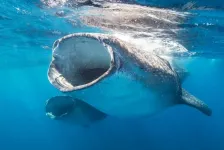(Press-News.org) Researchers have found that heavily used shipping lanes pass through crucial whale shark feeding grounds, posing a threat to this endangered species.
Research published today (Wednesday 15 May) in Science of the Total Environment has revealed areas where the sharks are at the highest risk of colliding with large shipping vessels by mapping the locations of whale shark aggregations and overlaying them with information on shipping traffic.
“The almost ubiquitous overlap of at least some large shipping vessel traffic with whale shark aggregations underlines the magnitude of the threat the shipping industry poses,” says lead author Dr Freya Womersley, a researcher at the Marine Research and Conservation Foundation (MARECO), the University of Southampton and the Marine Biological Association (MBA).
“Our findings highlight the need for targeted measures within these areas to reduce the risk of collision and improve the conservation status of endangered whale sharks.”
A growing concern
The world’s merchant fleet has doubled in size in the last 16 years. There are now more than 100,000 ships transporting goods worldwide and this number is expected to grow by as much as 1,200 per cent over the next ~27 years.
Collisions with wildlife – also known as ship strikes, are a growing concern and can be a leading cause of death for large marine animals, with more than 75 species at risk of population-level consequences.
Whale sharks have a declining population and spend almost half their time in surface waters, often in coastal areas that are heavily used by shipping vessels.
Dr Gonzalo Araujo, Director at MARECO, said: “Collisions with large ships are likely to be fatal for whale sharks, but evidence is scarce. That’s because whale sharks are slightly negatively buoyant, so their bodies sink. To inform conservation efforts, it’s important to quantify collision-related threats even when direct evidence is lacking.”
Identifying high-risk areas
Although they are mainly solitary creatures, whale sharks regularly come together in search of prey at special sites around the world called constellations. It is especially important to reduce threats to whale sharks inside constellations because the sharks are concentrated in high densities.
Researchers from MARECO, the University of Southampton, the MBA and Marine Megafauna Foundation (MMF) drew on the experience of specialists who study whale sharks around the world to map and gather insights on these constellations.
More than 75 experts responded to a series of survey questions and identified areas where they have encountered the most whale sharks (core habitats), as well as other places whale sharks have been spotted (buffer zones). In total 107 areas were identified in 26 countries. The experts reported observations from over 13 thousand individuals, representing over half of all identified whale sharks.
The team then used information on large ship positions – provided by Global Fishing Watch (www.globalfishingwatch.org) – to understand the density of shipping in each of the constellations.
Whale sharks were most in danger of coming into contact with large vessels off the coast of mainland Ecuador, Isla Mujeres and La Paz in Mexico, Ewing Bank in the northern Gulf of Mexico, Kota Kinabalu and Redang Island in Malaysia, Pintuyan in the Philippines, Musandam in Oman and around the Seychelles and Taiwan.
The researchers identified 39 of these sites where peaks in shipping activity coincided with peak seasonal occurrences of whale sharks, sometimes across several months.
Dr Chris Rohner, Principal Scientist at MMF said: “Many of these sites had more than one vessel per square kilometre in core habitats. For example, the constellation in Isla Mujeres in Mexico has an average of 56 ships passing through the core habitat monthly. These sites require urgent action to reduce the threats posed by shipping.”
Results showed that some experts involved in the study underestimated the threat posed by large ship collisions within constellation sites due to a lack of direct evidence, such as injuries or witness accounts, which are available for other, sub-lethal threat categories like tourism interactions and small vessel collisions.
Reducing the risk
The research team also looked at how this threat could be mitigated. They simulated vessel movements within the whale shark constellation at Ewing Bank, in the northern Gulf of Mexico.
They found that reducing the speed of vessels passing through the constellation by 75 per cent resulted in a small cost to shipping, with an approximate increase in total transit time of 5 per cent, on average, but a potentially high gain for whale sharks as slower ships can better see, and avoid collisions with, the sharks.
Dr Womersley said: “One of the benefits of speed reductions is that they can be temporarily introduced during whale shark peak seasons. These speed limits can also be applied to smaller vessels which are less deadly but can still damage the sharks.”
Rerouting the ships around core habits had even less of an impact – an approximate 0.5 per cent increase in total transit time (just 2.4 hours per vessel) and a 1.1 per cent increase in total distance travelled, on average.
Dr Araujo added: “Rerouting is the most direct way to reduce the risk of collision and our results suggest that this will often be more cost-effective than speed reduction, mainly because whale shark core sites are small. Movements of as little as 12 nm (22.2 km) away from of a core whale shark habitat could mean fast transiting ships avoid the site entirely.”
Amy Fraenkel, Executive Secretary of the Convention on the Conservation of Migratory Species of Wild Animals (CMS), noted: “CMS plays a pivotal role in securing the long-term survival of the whale shark – a globally endangered species. Ensuring the safety of this highly migratory species from vessel collisions within its migratory range particularly at aggregation sites, is a key goal under CMS.”
The researchers say support for these measures requires increased awareness and education of the issue as well as improved data but suggest effective management strategies could pave the way for coexistence between this important species and the shipping industry.
Identifying priority sites for whale shark ship collision management globally is published in Science of the Total Environment and is available Open Access online.
This study was partly funded by the German Federal Ministry of Environment, Nature Conservation, Nuclear Safety and Consumer Protection, and Marine Research and Conservation Foundation and was supported by the UK Natural Environment Research Council.
ENDS
1,071 WORDS
END
Most dangerous areas for whale shark-shipping vessel collisions revealed
Targeted measures could help protect endangered species with potentially minimal impact on the shipping industry, say researchers
2024-05-15
ELSE PRESS RELEASES FROM THIS DATE:
Petroleum, chlorine mix could yield harmful byproducts in new UH study
2024-05-15
A new study from the University of Hawaiʻi at Mānoa shows that chlorine mixed with petroleum in water can potentially produce inadvertent byproducts harmful to human health.
Small amounts of chlorine, within safe industry standards, are added to disinfect Oʻahu’s drinking water by the Honolulu Board of Water Supply (BWS) and military installations, according to BWS. In late November 2021, a petroleum release from the Red Hill Bulk Fuel Storage Facility contaminated the Red Hill ...
Novel inhibitor insights offer pathway to preventing PXR-associated drug resistance
2024-05-15
(Memphis, Tenn. – May 14, 2024) Deaths from cancer or infections can occur when available treatments are ineffective. Once turned on, pregnane X receptor (PXR) activates the expression of genes encoding enzymes that metabolize external chemicals, including drugs. This causes a significant drop in the effectiveness of chemotherapy, antivirals and other pharmaceuticals. Blocking the PXR activity is notoriously difficult, as many drugs that bind the protein, whether intentionally or unintentionally, activate it. Scientists at St. Jude Children’s Research ...
Higher income reduces stroke mortality risk by a third, new study shows
2024-05-15
(Wednesday, 15 May 2024, Basel, Switzerland) New research, presented today at the 10th European Stroke Organisation Conference (ESOC) 2024, has revealed that high-income individuals have a 32% lower risk of post-stroke mortality.1 Additionally, those with a higher education have a 26% lower risk of death post-stroke, highlighting striking disparities in stroke survival based on key social determinants of health (SDoH).
The register-based study analysed data from 6,901 stroke patients in Gothenburg, Sweden between November 2014 to December 2019 to examine ...
Text messages with financial incentives for men with obesity
2024-05-15
About The Study: Among men with obesity, an intervention with text messaging with financial incentive significantly improved weight loss compared with a control group, whereas text messaging alone was not significantly better than the control condition. These findings support text messaging combined with financial incentives to attain weight loss in men with obesity.
Quote from corresponding author Prof. Pat Hoddinott, M.B., B.S., Ph.D.:
“Losing weight can make people feel better, reduce their risk of many health problems such as diabetes, and helps the health service with their aim to keep ...
An adaptive behavioral intervention for weight loss management
2024-05-15
About The Study: A wireless feedback system (Wi-Fi activity tracker and scale with smartphone app to provide daily feedback) was not noninferior to the same system with added coaching. Continued efforts are needed to identify strategies for weight loss management and to accurately select interventions for different individuals to achieve weight loss goals.
Quote from corresponding author Bonnie Spring, Ph.D.:
“With U.S. obesity prevalence projected to reach 49% by 2030, limited obesity treatment resources need to be spread across more of the ...
Tech can’t replace human coaches in obesity treatment
2024-05-15
· The need for low cost but effective obesity treatments has become urgent
· ‘At this stage, treatment still needs a human because the tech alone doesn’t produce clinically acceptable weight loss for most people’
· Not previously known whether tech alone could produce clinically acceptable weight loss
CHICAGO --- A new Northwestern Medicine study shows that technology alone can’t replace the human touch to produce meaningful weight loss in obesity treatment.
“Giving people technology alone ...
Severe obesity in childhood can halve life expectancy, global modelling study finds
2024-05-15
Impact of age of onset, severity and duration of childhood obesity quantified for the first time
Early onset obesity model finds that a child who is living with severe obesity at age 4 and doesn’t lose weight has a life expectancy of just 39. But weight loss can give back decades of life
Childhood obesity is a life-threatening disease, say researchers
New research being presented at the European Congress on Obesity (ECO) in Venice, Italy (12-15 May) has, for the first time, quantified the impact of different aspects of childhood obesity on long-term health and life expectancy.
The modelling by stradoo GmbH, a life sciences consultancy ...
Study supports lower BMI threshold for obesity in the over 40s
2024-05-15
Changes in body composition with ageing—increases in body fat and declines in muscle—mean that BMI is not accurate in predicting obesity in middle-aged and older adults.
BMI identified half as many over 40s with obesity as predicted by body fat percentage.
A new lower BMI cut-off for obesity based on body fat percentage (27kg/m²) in the over 40s may be more appropriate than the existing WHO BMI threshold (30 kg/m²).
The authors say establishing this new lower BMI cut-off point for the over 40s in clinical settings and obesity guidelines potentially ...
Text messages with financial incentives can help men who are living with obesity lose weight, UK study finds (JAMA)
2024-05-15
Men in England, Scotland and Northern Ireland offered up to £400 for hitting weight loss targets lost more weight than those not given cash incentive
Win-win strategy could pay for itself, say researchers
*Note: this paper is being presented at the European Congress on Obesity (ECO) and is being published in JAMA. Please credit both the congress and the journal in your stories.*
A new study presented at the European Congress on Obesity (ECO) in Venice, Italy (12-15 May), and published simultaneously in JAMA, has concluded that text messages with financial incentives can help men who are living with obesity lose weight and could be a valuable alternative ...
Scientists develop an affordable sensor for lead contamination
2024-05-14
Engineers at MIT, Nanytang Technological University, and several companies have developed a compact and inexpensive technology for detecting and measuring lead concentrations in water, potentially enabling a significant advance in tackling this persistent global health issue.
The World Health Organization estimates that 240 million people worldwide are exposed to drinking water that contains unsafe amounts of toxic lead, which can affect brain development in children, cause birth defects, and produce a variety of neurological, cardiac, ...
LAST 30 PRESS RELEASES:
Ribosomal engineering creates “super-probiotic” bacteria
This self-powered eye tracker harnesses energy from blinking and is as comfortable as everyday glasses
Adverse prenatal exposures linked to higher rates of mental health issues, brain changes in adolescents
Restoring mitochondria shows promise for treating chronic nerve pain
Nature study identifies a molecular switch that controls transitions between single-celled and multicellular forms
USU chemists' CRISPR discovery could lead to single diagnostic test for COVID, flu, RSV
Early hominins from Morocco reveal an African lineage near the root of Homo sapiens
Small chimps, big risks: What chimps show us about our own behavior
We finally know how the most common types of planets are created
Thirty-year risk of cardiovascular disease among healthy women according to clinical thresholds of lipoprotein(a)
Yoga for opioid withdrawal and autonomic regulation
Gene therapy ‘switch’ may offer non-addictive pain relief
Study shows your genes determine how fast your DNA mutates with age
Common brain parasite can infect your immune cells. Here's why that's probably OK
International experts connect infections and aging through cellular senescence
An AI–DFT integrated framework accelerates materials discovery and design
Twist to reshape, shift to transform: Bilayer structure enables multifunctional imaging
CUNY Graduate Center and its academic partners awarded more than $1M by Google.org to advance statewide AI education through the Empire AI consortium
Mount Sinai Health system receives $8.5 million NIH grant renewal to advance research on long-term outcomes in children with congenital heart disease
Researchers develop treatment for advanced prostate cancer that could eliminate severe side effects
Keck Medicine of USC names Christian Pass chief financial officer
Inflatable fabric robotic arm picks apples
MD Anderson and SOPHiA GENETICS announce strategic collaboration to accelerate AI-driven precision oncology
Oil residues can travel over 5,000 miles on ocean debris, study finds
Korea University researchers discover that cholesterol-lowering drug can overcome chemotherapy resistance in triple-negative breast cancer
Ushikuvirus: A newly discovered giant virus may offer clues to the origin of life
Boosting the cell’s own cleanup
Movement matters: Light activity led to better survival in diabetes, heart, kidney disease
Method developed to identify best treatment combinations for glioblastoma based on unique cellular targets
Self-guided behavioral app helps children with epilepsy sleep earlier
[Press-News.org] Most dangerous areas for whale shark-shipping vessel collisions revealedTargeted measures could help protect endangered species with potentially minimal impact on the shipping industry, say researchers


